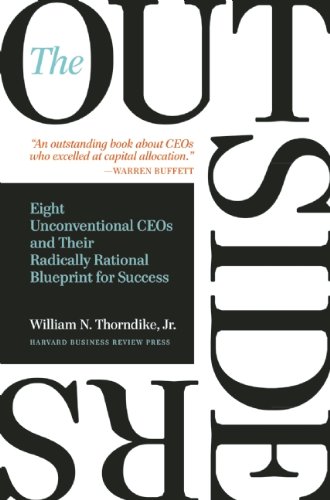

This article is an excerpt from the Shortform summary of "The Outsiders" by William N. Thorndike, Jr. Shortform has the world's best summaries of books you should be reading.
Like this article? Sign up for a free trial here .
What if you’re not a CEO of a large public company, and want ideas on small business financial management? Are the decisions made by CEOs relevant to everyday managers and business owners?
The author of The Outsiders argues yes—that small business financial management has principles that are tied into being an Outsider CEO. You can think about your small business financial management in terms of capital allocation and cash deployment too- and it just might help your business grow.
How Can Strategies of CEO’s Work for Small Business Management?
In The Outsiders, the author highlights eight top CEOs. But the purpose of their work is to show a rational approach to capital allocation: figure out the value of all the options available to you, then choose the most profitable ones, ignoring conventional wisdom and what your competitors are doing. This will undoubtedly help with small business management as well.
Here’s a realistic example of this idea in small business management. Imagine you own a single-location bakery, and you have more demand than you can service. You consider two possible options: 1) expanding your current store, 2) opening a second store in a new location.
Using the checklist of the outsider CEOs, work through the following steps:
- Determine your personal hurdle rate for investments. Say it’s a 20% annual return on investment.
- Calculate the costs of both options.
- 1) Expanding your current store might cost $50,000 for a new oven and $50,000 for renovations, for a total upfront cost of $100,000
- 2) Opening a second store might cost $50,000 for a new oven and $150,000 for new building expenses, for a total upfront cost of $200,000.
- Calculate the additional profits enabled by each option.
- 1) Expanding your current store allows you to service the existing demand that you currently can’t serve. You estimate, after operating costs, expanding will net $20,000 in additional profits.
- 2) Opening a second store lets you access more demand than your current store, but there is also risk in misestimating demand. You estimate, after operating costs, opening a second store will net $40,000-$75,000 in additional profits.
- Calculate the ROI of each option, and compare to your hurdle rate.
- 1) $20,000 in additional profits over $100,000 in upfront costs is a 20% return. This just meets your hurdle rate.
- 2) $40,000-$75,000 in additional profits over $200,000 in upfront costs is a return between 25% and 37.5%. This is a higher return, accompanied by higher risk.
- Consider the major assumptions in your understanding of the situation.
- How confident are you in the sales estimates for your second location in a new location? How might you be wrong about this?
- Opening a second store requires $100,000 more investment than expanding your current store. How can you access this capital? How much will it cost?
- Are there any qualitative benefits to the new store? For example, does it better build capabilities to pave the way for future expansion? Does it diversify your revenue so you are less dependent on your current store?
Even though this example concerns small business money management, it uses the same thought process that CEOs of Fortune 500 companies use. And by going through this decision methodically like outsider CEOs, you’ll arrive at the optimal answer for your situation—regardless of what conventional wisdom tells you to do or what your competitors are doing. Definitely a win for small business financial management.
Being Unorthodox Gets Results for Small Businesses, Too
CEOs and companies with standout performance in the latter half of the 20th century can show businesses of all sizes how to strategize in unorthodox ways, and how to improve their small business management. Looking deeper into their management practices, top CEOs have virtually identical patterns to their management style that were unorthodox but directly caused their outsized results. By adapting these management styles and strategies to fit your business, you can use unorthodox strategies that work for your small business money management tactics.
In The Outsiders, the author found uncannily strong patterns among the outsider CEOs that distinguished them from typical CEOs. This concerned three areas:
- Their approach to capital allocation
- Their management practices
- Their personality traits
In all three areas, outsider CEOs departed from common wisdom about how to operate a company and behave as a CEO.
This departure from conventional thinking makes logical sense. By doing the same things as everyone else, you’re restricted to average performance. You need to do unorthodox things to get unorthodox results. Think about this in the context of a small business; how can you stand out from your competitors? How can you reframe this as small business money management?
Note that the optimal choices vary from company to company, from industry to industry. The point is not to blindly mirror what the outsider CEOs did—it’s to examine all of the tools in your toolkit, and choose the best one based on rational analysis.
When it comes to small business financial management, there are the everyday finances to consider, plus the goals of growing and increasing your business. Through smart small business financial management, you can do both; you can come up with unorthodox ways to use cash flow while continuing to provide the great services you’re known for.

———End of Preview———
Like what you just read? Read the rest of the world's best summary of William N. Thorndike, Jr's "The Outsiders" at Shortform .
Here's what you'll find in our full The Outsiders summary :
- What great CEOs like Warren Buffett do that average CEOs don't
- How to master the art of capital allocation
- How to be a great manager that your team is excited to work with






